Aofan Jiang
Self-supervised Anomaly Detection Pretraining Enhances Long-tail ECG Diagnosis
Aug 30, 2024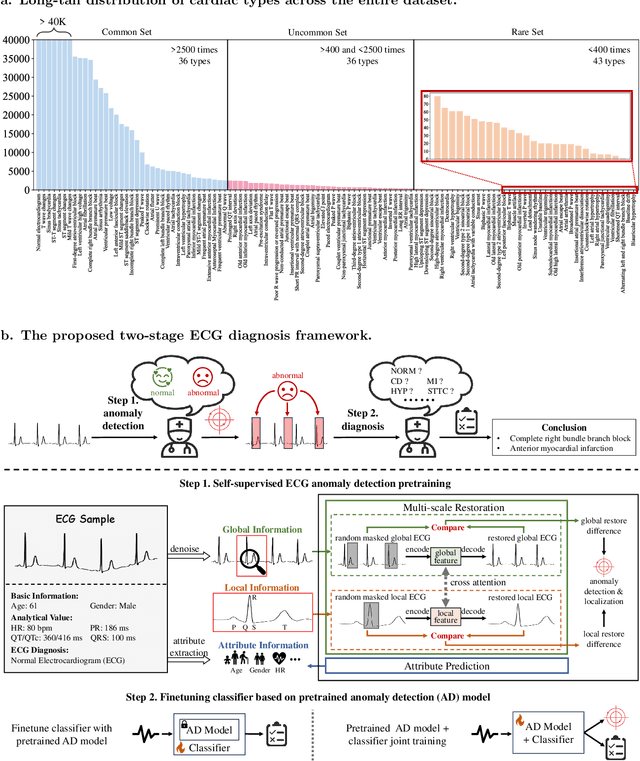
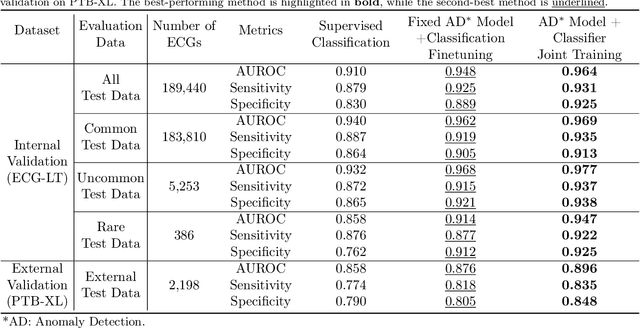
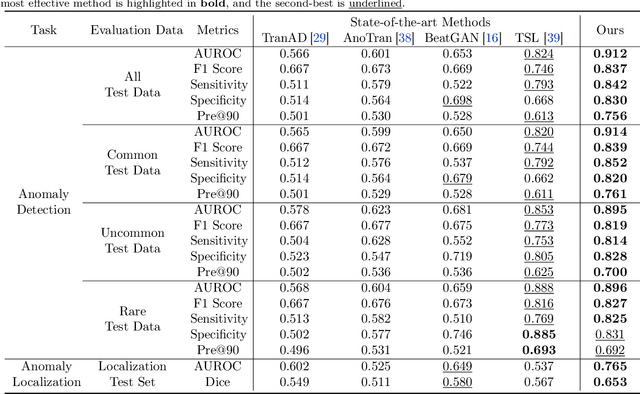
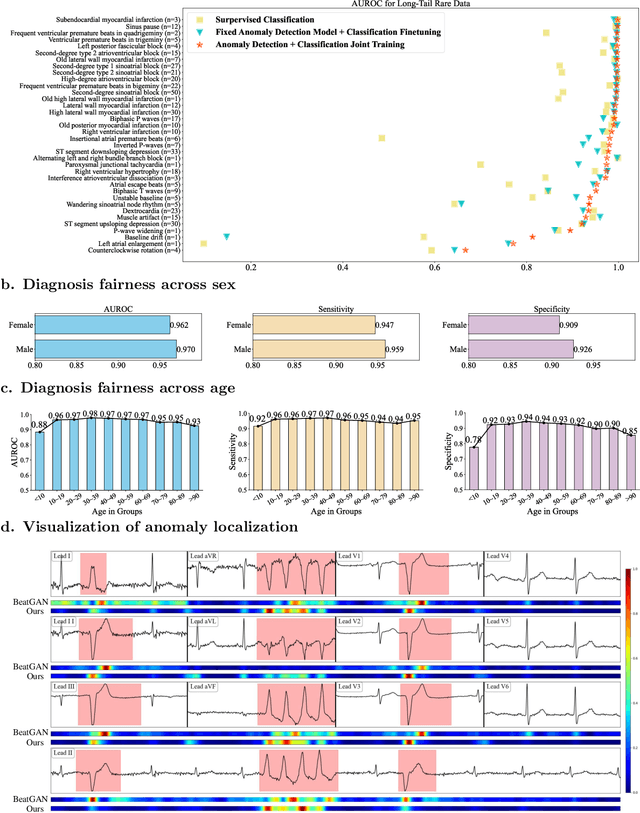
Abstract:Current computer-aided ECG diagnostic systems struggle with the underdetection of rare but critical cardiac anomalies due to the imbalanced nature of ECG datasets. This study introduces a novel approach using self-supervised anomaly detection pretraining to address this limitation. The anomaly detection model is specifically designed to detect and localize subtle deviations from normal cardiac patterns, capturing the nuanced details essential for accurate ECG interpretation. Validated on an extensive dataset of over one million ECG records from clinical practice, characterized by a long-tail distribution across 116 distinct categories, the anomaly detection-pretrained ECG diagnostic model has demonstrated a significant improvement in overall accuracy. Notably, our approach yielded a 94.7% AUROC, 92.2% sensitivity, and 92.5\% specificity for rare ECG types, significantly outperforming traditional methods and narrowing the performance gap with common ECG types. The integration of anomaly detection pretraining into ECG analysis represents a substantial contribution to the field, addressing the long-standing challenge of long-tail data distributions in clinical diagnostics. Furthermore, prospective validation in real-world clinical settings revealed that our AI-driven approach enhances diagnostic efficiency, precision, and completeness by 32%, 6.7%, and 11.8% respectively, when compared to standard practices. This advancement marks a pivotal step forward in the integration of AI within clinical cardiology, with particularly profound implications for emergency care, where rapid and accurate ECG interpretation is crucial. The contributions of this study not only push the boundaries of current ECG diagnostic capabilities but also lay the groundwork for more reliable and accessible cardiovascular care.
Few-Shot Anomaly Detection via Category-Agnostic Registration Learning
Jun 13, 2024Abstract:Most existing anomaly detection methods require a dedicated model for each category. Such a paradigm, despite its promising results, is computationally expensive and inefficient, thereby failing to meet the requirements for real-world applications. Inspired by how humans detect anomalies, by comparing a query image to known normal ones, this paper proposes a novel few-shot anomaly detection (FSAD) framework. Using a training set of normal images from various categories, registration, aiming to align normal images of the same categories, is leveraged as the proxy task for self-supervised category-agnostic representation learning. At test time, an image and its corresponding support set, consisting of a few normal images from the same category, are supplied, and anomalies are identified by comparing the registered features of the test image to its corresponding support image features. Such a setup enables the model to generalize to novel test categories. It is, to our best knowledge, the first FSAD method that requires no model fine-tuning for novel categories: enabling a single model to be applied to all categories. Extensive experiments demonstrate the effectiveness of the proposed method. Particularly, it improves the current state-of-the-art for FSAD by 11.3% and 8.3% on the MVTec and MPDD benchmarks, respectively. The source code is available at https://github.com/Haoyan-Guan/CAReg.
Anomaly Detection in Electrocardiograms: Advancing Clinical Diagnosis Through Self-Supervised Learning
Apr 07, 2024



Abstract:The electrocardiogram (ECG) is an essential tool for diagnosing heart disease, with computer-aided systems improving diagnostic accuracy and reducing healthcare costs. Despite advancements, existing systems often miss rare cardiac anomalies that could be precursors to serious, life-threatening issues or alterations in the cardiac macro/microstructure. We address this gap by focusing on self-supervised anomaly detection (AD), training exclusively on normal ECGs to recognize deviations indicating anomalies. We introduce a novel self-supervised learning framework for ECG AD, utilizing a vast dataset of normal ECGs to autonomously detect and localize cardiac anomalies. It proposes a novel masking and restoration technique alongside a multi-scale cross-attention module, enhancing the model's ability to integrate global and local signal features. The framework emphasizes accurate localization of anomalies within ECG signals, ensuring the method's clinical relevance and reliability. To reduce the impact of individual variability, the approach further incorporates crucial patient-specific information from ECG reports, such as age and gender, thus enabling accurate identification of a broad spectrum of cardiac anomalies, including rare ones. Utilizing an extensive dataset of 478,803 ECG graphic reports from real-world clinical practice, our method has demonstrated exceptional effectiveness in AD across all tested conditions, regardless of their frequency of occurrence, significantly outperforming existing models. It achieved superior performance metrics, including an AUROC of 91.2%, an F1 score of 83.7%, a sensitivity rate of 84.2%, a specificity of 83.0%, and a precision of 75.6% with a fixed recall rate of 90%. It has also demonstrated robust localization capabilities, with an AUROC of 76.5% and a Dice coefficient of 65.3% for anomaly localization.
Adapting Visual-Language Models for Generalizable Anomaly Detection in Medical Images
Mar 19, 2024Abstract:Recent advancements in large-scale visual-language pre-trained models have led to significant progress in zero-/few-shot anomaly detection within natural image domains. However, the substantial domain divergence between natural and medical images limits the effectiveness of these methodologies in medical anomaly detection. This paper introduces a novel lightweight multi-level adaptation and comparison framework to repurpose the CLIP model for medical anomaly detection. Our approach integrates multiple residual adapters into the pre-trained visual encoder, enabling a stepwise enhancement of visual features across different levels. This multi-level adaptation is guided by multi-level, pixel-wise visual-language feature alignment loss functions, which recalibrate the model's focus from object semantics in natural imagery to anomaly identification in medical images. The adapted features exhibit improved generalization across various medical data types, even in zero-shot scenarios where the model encounters unseen medical modalities and anatomical regions during training. Our experiments on medical anomaly detection benchmarks demonstrate that our method significantly surpasses current state-of-the-art models, with an average AUC improvement of 6.24% and 7.33% for anomaly classification, 2.03% and 2.37% for anomaly segmentation, under the zero-shot and few-shot settings, respectively. Source code is available at: https://github.com/MediaBrain-SJTU/MVFA-AD
Multi-Scale Memory Comparison for Zero-/Few-Shot Anomaly Detection
Aug 09, 2023Abstract:Anomaly detection has gained considerable attention due to its broad range of applications, particularly in industrial defect detection. To address the challenges of data collection, researchers have introduced zero-/few-shot anomaly detection techniques that require minimal normal images for each category. However, complex industrial scenarios often involve multiple objects, presenting a significant challenge. In light of this, we propose a straightforward yet powerful multi-scale memory comparison framework for zero-/few-shot anomaly detection. Our approach employs a global memory bank to capture features across the entire image, while an individual memory bank focuses on simplified scenes containing a single object. The efficacy of our method is validated by its remarkable achievement of 4th place in the zero-shot track and 2nd place in the few-shot track of the Visual Anomaly and Novelty Detection (VAND) competition.
Multi-scale Cross-restoration Framework for Electrocardiogram Anomaly Detection
Aug 03, 2023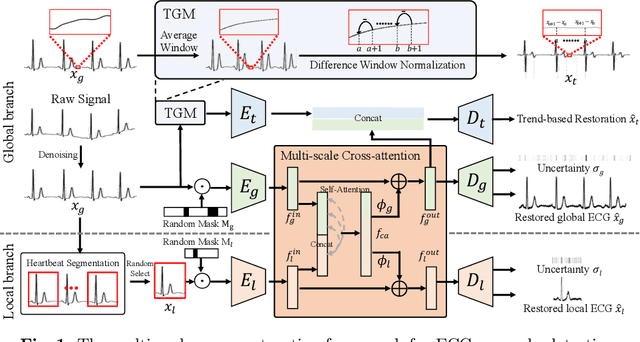
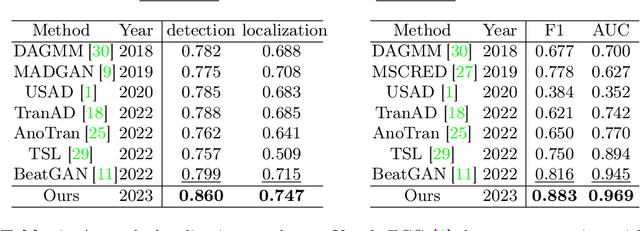
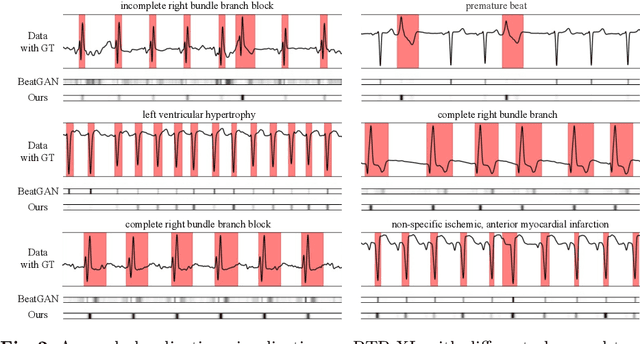
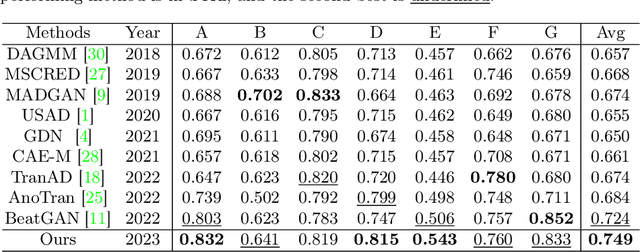
Abstract:Electrocardiogram (ECG) is a widely used diagnostic tool for detecting heart conditions. Rare cardiac diseases may be underdiagnosed using traditional ECG analysis, considering that no training dataset can exhaust all possible cardiac disorders. This paper proposes using anomaly detection to identify any unhealthy status, with normal ECGs solely for training. However, detecting anomalies in ECG can be challenging due to significant inter-individual differences and anomalies present in both global rhythm and local morphology. To address this challenge, this paper introduces a novel multi-scale cross-restoration framework for ECG anomaly detection and localization that considers both local and global ECG characteristics. The proposed framework employs a two-branch autoencoder to facilitate multi-scale feature learning through a masking and restoration process, with one branch focusing on global features from the entire ECG and the other on local features from heartbeat-level details, mimicking the diagnostic process of cardiologists. Anomalies are identified by their high restoration errors. To evaluate the performance on a large number of individuals, this paper introduces a new challenging benchmark with signal point-level ground truths annotated by experienced cardiologists. The proposed method demonstrates state-of-the-art performance on this benchmark and two other well-known ECG datasets. The benchmark dataset and source code are available at: \url{https://github.com/MediaBrain-SJTU/ECGAD}
Registration based Few-Shot Anomaly Detection
Jul 15, 2022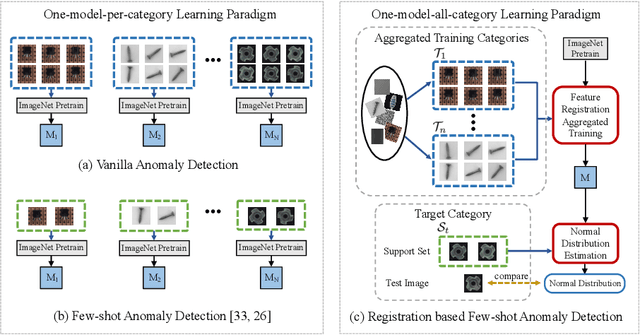
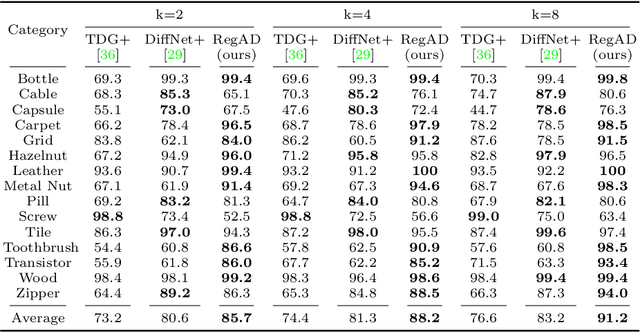


Abstract:This paper considers few-shot anomaly detection (FSAD), a practical yet under-studied setting for anomaly detection (AD), where only a limited number of normal images are provided for each category at training. So far, existing FSAD studies follow the one-model-per-category learning paradigm used for standard AD, and the inter-category commonality has not been explored. Inspired by how humans detect anomalies, i.e., comparing an image in question to normal images, we here leverage registration, an image alignment task that is inherently generalizable across categories, as the proxy task, to train a category-agnostic anomaly detection model. During testing, the anomalies are identified by comparing the registered features of the test image and its corresponding support (normal) images. As far as we know, this is the first FSAD method that trains a single generalizable model and requires no re-training or parameter fine-tuning for new categories. Experimental results have shown that the proposed method outperforms the state-of-the-art FSAD methods by 3%-8% in AUC on the MVTec and MPDD benchmarks.
 Add to Chrome
Add to Chrome Add to Firefox
Add to Firefox Add to Edge
Add to Edge